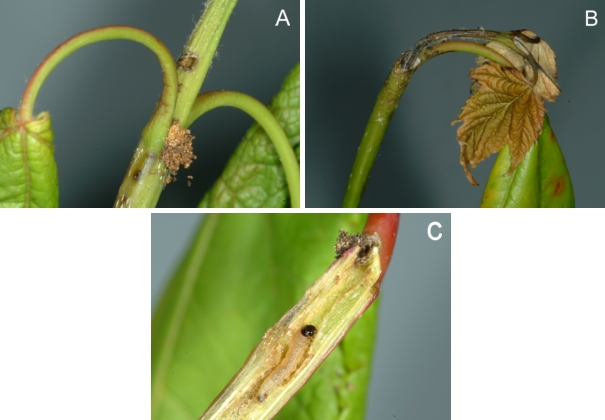Maple Shoot Borer
ENTFACT-455: Maple Shoot Borer | Download PDF
by Sarah J. Vanek, Extension Associate for Nursery Crop Production
University of Kentucky College of Agriculture
Importance to the Nursery Industry
Maple shoot borer, Proteoterus aesculana (Riley) (Lepidoptera: Tortricidae), also known by the common names maple tip moth and maple twig borer, is a key insect pest of young maple trees in nurseries. Larvae cause tip dieback and flagging by tunneling into young growing shoots.
Researchers at the University of Kentucky found that in some fields of newly transplanted Acer rubrum bare-root liners, as many as 100% of the trees were infested and 22–36% suffered flagging in the terminal leader (Seagraves et al, 2008).
Destruction of the terminal leader causes undesirable forking and requires establishment of a new central leader. This increases labor costs and leaves an unattractive crook in the tree even when performed successfully.
Maple shoot borer, a key pest for maple tree producers, can cause dieback in the terminal leader.

Signs and symptoms of maple shoot borer: A, frass and silk expelled from infested shoot; B, flagged maple shoot; C, exposed larva tunneling within damaged shoot. Photos by B.L. Seagraves and R. Bessin.
Distribution
This moth occurs throughout much of the United States and southern Canada from Oregon and southern Alberta to the East Coast, and south through Kentucky and Tennessee to Mississippi (Seagraves, 2006).
Hosts
Maple shoot borer attacks members of the genus Acer, primarily red (A. rubrum) and Freeman (A. freemanii) maples. Sugar maple (A. saccharum) is also a relatively common host.
Life Cycle
Adult moths are active from mid-March to early May, with peak activity in early to mid-April. During this time, females lay eggs, most likely on twigs near green-tipped or opening buds. Following egg hatch, the caterpillar burrows into the young shoot where it feeds until late May or early June. The mature larva exits the shoot before pupating. The location of pupation is unknown.
Completion of this generation’s development causes a second, smaller period of adult activity starting in late May or June and diminishing by July or August.
However, shoot damage caused by the larval stage has not been found following the May-June flight pulse. It is possible that moths that emerge during this secondary flight pulse seek overwintering sites where they remain until the following spring (Seagraves et al., 2008).
Appearance
The adult is a very small (< 1 cm long) light brown moth. The larva is a relatively smooth, cream-colored caterpillar with a distinct black head.
Signs and Symptoms
Young stems and leaves, apical to the point of larval tunneling, wilt and eventually die. This flagging first appears in late April or May. Each infested shoot has a small hole near a leaf petiole axil with a small mass of expelled frass (sawdust-like fecal matter) mixed with silk. Throughout most of May, infested shoots can be sliced open to find the tunneling larva.
Management
Contrary to previous notions, dormant liners shipped from West Coast nurseries are not infested before being shipped. Rather, trees become infested with eggs shortly before leaf bud break, so management of the pest is the responsibility of the receiver.
Preventive control can be achieved with a single spray application of a pyrethroid insecticide any time from just before bud break, which typically occurs in mid-March, until most shoots have flushed their first two pairs of small (< 1” long) leaves in April. This management strategy provides as much as 96–100% control of the pest.
A single insecticide treatment any time shortly before bud break until shoots have two pairs of leaves can provide nearly 100% control.
Natural Enemies
Natural enemies include parasitoid wasps within the families Braconidae and Eulophidae.
Reference
Information in this article comes from the following publication:
- Seagraves, B.L., K.F. Haynes, C.T. Redmond, S. Tittle, and D.A. Potter. 2008. Seasonal biology and management of the maple shoot borer,Proteoteras aesculana (Lepidoptera: Tortricidae), in production nurseries. Pest Manag Sci 64: 1040–1049
Issued: 10/11
CAUTION! Pesticide recommendations in this publication are registered for use in Kentucky, USA ONLY! The use of some products may not be legal in your state or country. Please check with your local county agent or regulatory official before using any pesticide mentioned in this publication.
Of course, ALWAYS READ AND FOLLOW LABEL DIRECTIONS FOR SAFE USE OF ANY PESTICIDE!
Images: University of Kentucky College of Agriculture
